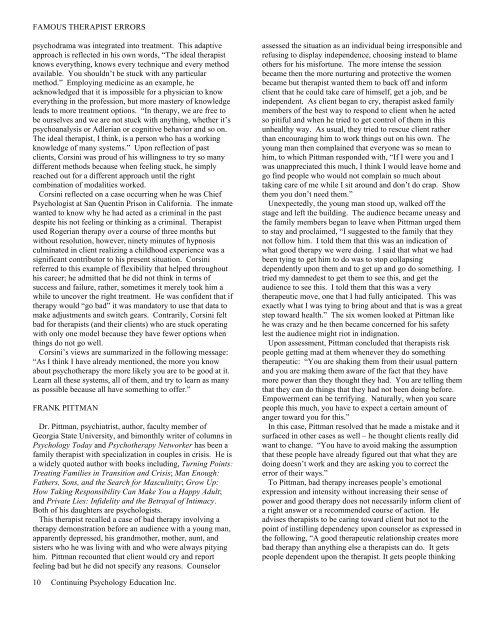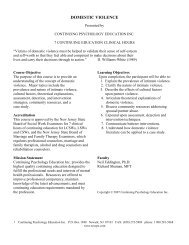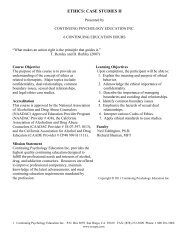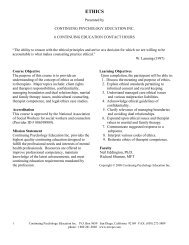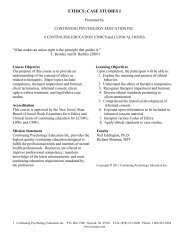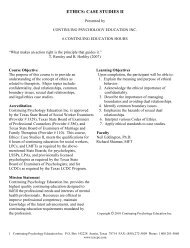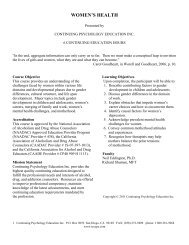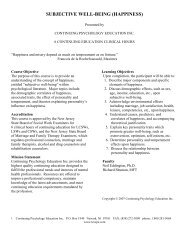FAMOUS THERAPIST ERRORS - Continuing Psychology Education
FAMOUS THERAPIST ERRORS - Continuing Psychology Education
FAMOUS THERAPIST ERRORS - Continuing Psychology Education
You also want an ePaper? Increase the reach of your titles
YUMPU automatically turns print PDFs into web optimized ePapers that Google loves.
<strong>FAMOUS</strong> <strong>THERAPIST</strong> <strong>ERRORS</strong>psychodrama was integrated into treatment. This adaptiveapproach is reflected in his own words, “The ideal therapistknows everything, knows every technique and every methodavailable. You shouldn’t be stuck with any particularmethod.” Employing medicine as an example, heacknowledged that it is impossible for a physician to knoweverything in the profession, but more mastery of knowledgeleads to more treatment options. “In therapy, we are free tobe ourselves and we are not stuck with anything, whether it’spsychoanalysis or Adlerian or cognitive behavior and so on.The ideal therapist, I think, is a person who has a workingknowledge of many systems.” Upon reflection of pastclients, Corsini was proud of his willingness to try so manydifferent methods because when feeling stuck, he simplyreached out for a different approach until the rightcombination of modalities worked.Corsini reflected on a case occurring when he was ChiefPsychologist at San Quentin Prison in California. The inmatewanted to know why he had acted as a criminal in the pastdespite his not feeling or thinking as a criminal. Therapistused Rogerian therapy over a course of three months butwithout resolution, however, ninety minutes of hypnosisculminated in client realizing a childhood experience was asignificant contributor to his present situation. Corsinireferred to this example of flexibility that helped throughouthis career; he admitted that he did not think in terms ofsuccess and failure, rather, sometimes it merely took him awhile to uncover the right treatment. He was confident that iftherapy would “go bad” it was mandatory to use that data tomake adjustments and switch gears. Contrarily, Corsini feltbad for therapists (and their clients) who are stuck operatingwith only one model because they have fewer options whenthings do not go well.Corsini’s views are summarized in the following message:“As I think I have already mentioned, the more you knowabout psychotherapy the more likely you are to be good at it.Learn all these systems, all of them, and try to learn as manyas possible because all have something to offer.”FRANK PITTMANDr. Pittman, psychiatrist, author, faculty member ofGeorgia State University, and bimonthly writer of columns in<strong>Psychology</strong> Today and Psychotherapy Networker has been afamily therapist with specialization in couples in crisis. He isa widely quoted author with books including, Turning Points:Treating Families in Transition and Crisis; Man Enough:Fathers, Sons, and the Search for Masculinity; Grow Up:How Taking Responsibility Can Make You a Happy Adult;and Private Lies: Infidelity and the Betrayal of Intimacy.Both of his daughters are psychologists.This therapist recalled a case of bad therapy involving atherapy demonstration before an audience with a young man,apparently depressed, his grandmother, mother, aunt, andsisters who he was living with and who were always pityinghim. Pittman recounted that client would cry and reportfeeling bad but he did not specify any reasons. Counselorassessed the situation as an individual being irresponsible andrefusing to display independence, choosing instead to blameothers for his misfortune. The more intense the sessionbecame then the more nurturing and protective the womenbecame but therapist wanted them to back off and informclient that he could take care of himself, get a job, and beindependent. As client began to cry, therapist asked familymembers of the best way to respond to client when he actedso pitiful and when he tried to get control of them in thisunhealthy way. As usual, they tried to rescue client ratherthan encouraging him to work things out on his own. Theyoung man then complained that everyone was so mean tohim, to which Pittman responded with, “If I were you and Iwas unappreciated this much, I think I would leave home andgo find people who would not complain so much abouttaking care of me while I sit around and don’t do crap. Showthem you don’t need them.”Unexpectedly, the young man stood up, walked off thestage and left the building. The audience became uneasy andthe family members began to leave when Pittman urged themto stay and proclaimed, “I suggested to the family that theynot follow him. I told them that this was an indication ofwhat good therapy we were doing. I said that what we hadbeen tying to get him to do was to stop collapsingdependently upon them and to get up and go do something. Itried my damnedest to get them to see this, and get theaudience to see this. I told them that this was a verytherapeutic move, one that I had fully anticipated. This wasexactly what I was tying to bring about and that is was a greatstep toward health.” The six women looked at Pittman likehe was crazy and he then became concerned for his safetylest the audience might riot in indignation.Upon assessment, Pittman concluded that therapists riskpeople getting mad at them whenever they do somethingtherapeutic: “You are shaking them from their usual patternand you are making them aware of the fact that they havemore power than they thought they had. You are telling themthat they can do things that they had not been doing before.Empowerment can be terrifying. Naturally, when you scarepeople this much, you have to expect a certain amount ofanger toward you for this.”In this case, Pittman resolved that he made a mistake and itsurfaced in other cases as well – he thought clients really didwant to change. “You have to avoid making the assumptionthat these people have already figured out that what they aredoing doesn’t work and they are asking you to correct theerror of their ways.”To Pittman, bad therapy increases people’s emotionalexpression and intensity without increasing their sense ofpower and good therapy does not necessarily inform client ofa right answer or a recommended course of action. Headvises therapists to be caring toward client but not to thepoint of instilling dependency upon counselor as expressed inthe following, “A good therapeutic relationship creates morebad therapy than anything else a therapists can do. It getspeople dependent upon the therapist. It gets people thinking10 <strong>Continuing</strong> <strong>Psychology</strong> <strong>Education</strong> Inc.


